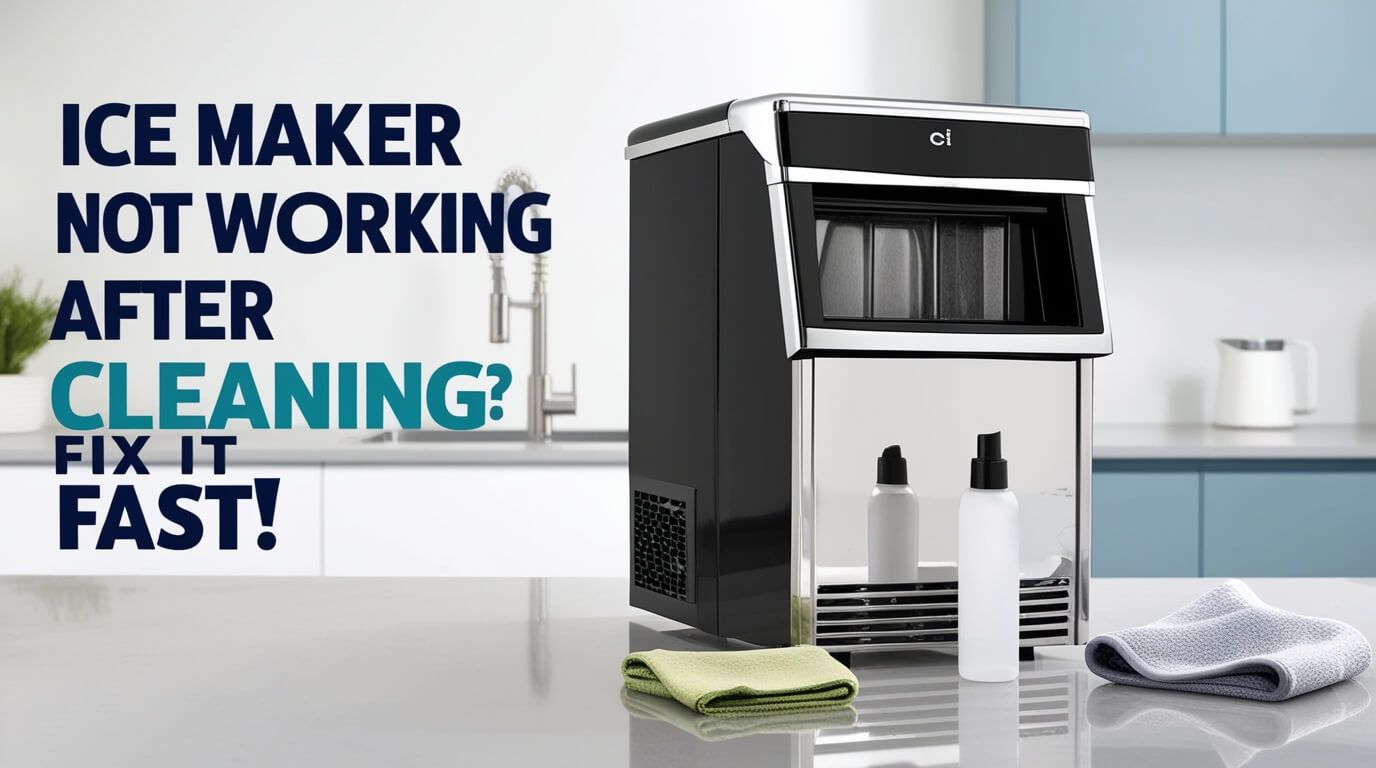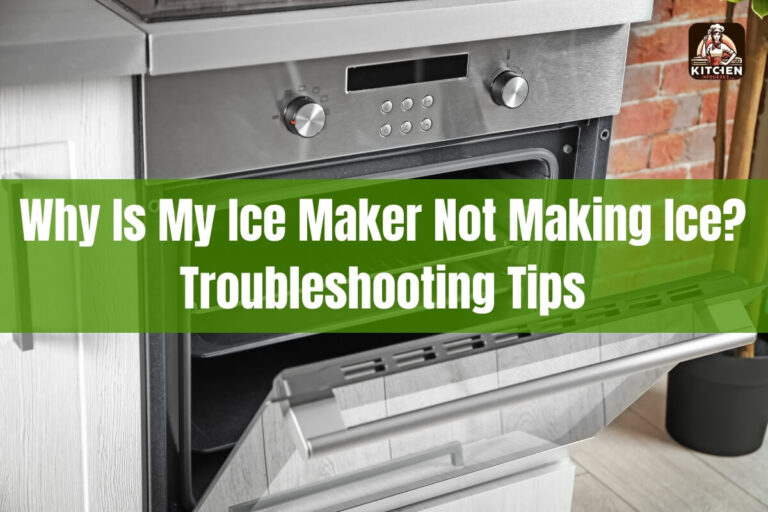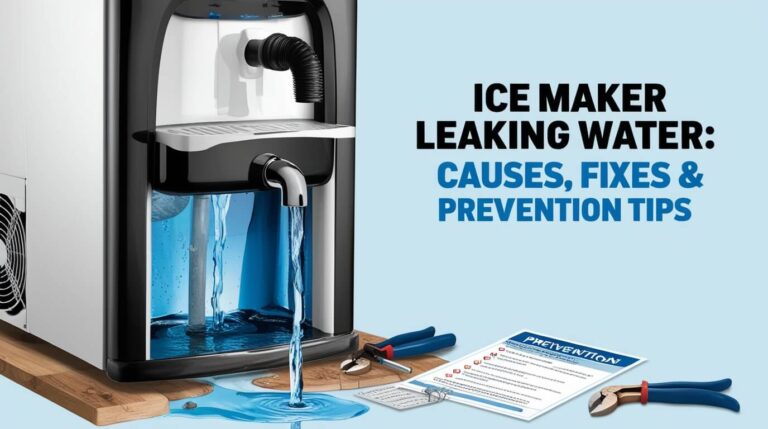
Just cleaned your ice maker but now it’s not working? Don’t worry. Many people face this issue. Ice makers can be tricky, and cleaning sometimes causes problems. This guide covers why your ice maker might stop working after cleaning and how to fix it.
We’ll look at common issues like no ice, weird-tasting cubes, and other cleaning-related problems. By the end, you’ll know how to get your ice maker back in action.
How Ice Makers Work
Before we tackle troubleshooting, it’s crucial to understand how ice makers work. This knowledge will help you pinpoint potential issues more effectively.
Ice makers are pretty clever machines. They use a combination of water, cold temperatures, and mechanical parts to create those refreshing ice cubes we all love. Here’s a quick rundown:
- Water fills a mold
- The mold freezes the water
- A heating element loosens the ice
- An ejector arm pushes out the ice
- The process repeats
Common Ice Maker Components
Knowing the key parts of your ice maker can help you troubleshoot more effectively:
- Water inlet valve
- Ice mold
- Thermostat
- Ejector arm
- Control module
These components work together to keep your ice supply flowing. When one part fails, it can throw off the entire system.
Why Clean Your Ice Maker?
You might be wondering why cleaning your ice maker is necessary in the first place. Let’s explore the importance of this maintenance task.
Importance of Regular Maintenance
Regular cleaning keeps your ice maker running smoothly and produces better-tasting ice. It removes mineral buildup, prevents mold growth, and ensures all parts are functioning correctly.
Signs Your Ice Maker Needs Cleaning
Watch out for these telltale signs that it’s time to clean your ice maker:
- Cloudy or smelly ice
- Slow ice production
- Strange noises during operation
- Visible dirt or grime
Proper Ice Maker Cleaning Techniques
Now that we understand the importance of cleaning, let’s review the correct way to clean your ice maker to avoid post-cleaning issues.
Step-by-Step Cleaning Process
- Unplug the refrigerator or turn off the ice maker
- Remove the ice bin and dispose of any ice
- Wash the bin with mild soap and warm water
- Clean the ice maker interior with a soft cloth and cleaning solution
- Rinse thoroughly with clean water
- Dry all components completely
- Reassemble and power on
Recommended Cleaning Products
Use cleaning products specifically designed for ice makers or a mixture of water and white vinegar. Avoid harsh chemicals that could damage components or leave residues.
Common Issues After Cleaning
Despite your best efforts, you might encounter some problems after cleaning. Let’s explore the most common issues.
No Ice Production
If your ice maker has gone completely silent, it could be due to:
- Disconnected water supply
- Frozen water line
- Faulty water inlet valve
Small or Misshapen Ice Cubes
Odd-looking ice cubes might indicate:
- Low water pressure
- Partially clogged water lines
- Incorrect freezer temperature
Strange Taste or Odor in Ice
If your ice tastes or smells funny after cleaning, consider:
- Residual cleaning solution
- Contaminated water supply
- Old or dirty water filter
Troubleshooting Ice Maker Problems Post-Cleaning
Let’s roll up our sleeves and get into some hands-on troubleshooting for your ice maker not working after cleaning.
Check Water Supply and Connections
First things first, make sure your ice maker is getting water:
- Inspect the water line for kinks or damage
- Verify the water valve is fully open
- Check for any loose connections
Inspect the Water Filter
A clogged or improperly installed water filter can halt ice production:
- Locate your refrigerator’s water filter
- Remove and inspect for damage or blockages
- Replace if necessary, following manufacturer instructions
Examine the Ice Maker Assembly
Sometimes, cleaning can dislodge important components:
- Check the ejector arm for proper positioning
- Ensure the ice mold is securely in place
- Look for any visible damage to the assembly
Verify Thermostat Settings
Incorrect temperature settings can prevent ice formation:
- Confirm your freezer is set to 0°F (-18°C)
- Allow 24 hours for temperature to stabilize after adjustments
Potential Causes of Ice Maker Malfunction
If basic troubleshooting doesn’t solve the problem, let’s look at some deeper issues that might be causing your ice maker to malfunction after cleaning.
Clogged Water Lines
Mineral deposits can build up over time, restricting water flow:
- Disconnect the water line
- Flush with a mixture of water and vinegar
- Reconnect and test
Faulty Water Inlet Valve
This valve controls water flow into the ice maker:
- Locate the valve (usually behind the refrigerator)
- Check for proper electrical connection
- Listen for a humming sound when the ice maker calls for water
Defective Ice Maker Module
The control module is the brain of your ice maker:
- Look for visible damage or corrosion
- Check if the module is receiving power
- Consider professional testing if unsure
Issues with the Control Board
A malfunctioning control board can disrupt ice maker operation:
- Inspect for any burnt or damaged areas
- Verify all connections are secure
- Test with a multimeter if you’re comfortable with electronics
DIY Fixes for Ice Maker Issues
Before calling in the pros, try these DIY solutions to get your ice maker working after cleaning.
Resetting Your Ice Maker
Sometimes, a simple reset can solve the problem:
- Locate the reset button (usually on the front or bottom of the ice maker)
- Press and hold for 3-5 seconds
- Wait 24 hours to see if ice production resumes
Thawing Frozen Components
If you suspect frozen parts are the culprit:
- Unplug the refrigerator
- Remove the ice maker cover
- Use a hair dryer on low heat to gently thaw any ice buildup
- Reassemble and test
Adjusting Water Pressure
Low water pressure can hinder ice production:
- Check your home’s water pressure (should be between 20-120 psi)
- Install a water pressure regulator if necessary
- Consider a water pressure booster for consistent flow
When to Call a Professional
While DIY solutions can often fix ice maker issues, some problems require expert attention.
Signs of Serious Ice Maker Problems
Consider professional help if you encounter:
- Electrical issues or burning smells
- Water leaks inside the refrigerator
- Persistent problems despite troubleshooting
Benefits of Professional Repair Services
Professional technicians offer:
- Accurate diagnosis of complex issues
- Access to specialized tools and parts
- Warranty on repairs
- Peace of mind
Preventing Future Ice Maker Issues
An ounce of prevention is worth a pound of cure, especially when it comes to ice makers.
Regular Maintenance Tips
Keep your ice maker running smoothly with these tips:
- Clean every 3-6 months
- Replace water filters as recommended
- Inspect water lines regularly for damage
- Keep the freezer at the optimal temperature
Best Practices for Ice Maker Care
Extend your ice maker’s life with these best practices:
- Use filtered water to reduce mineral buildup
- Avoid overfilling the ice bin
- Clean spills immediately to prevent component damage
- Consider a water softener if you have hard water
Conclusion: Restoring Your Ice Maker’s Functionality
Dealing with an ice maker not working after cleaning can be frustrating, but it’s often a solvable problem. By understanding how your ice maker works, following proper cleaning techniques, and troubleshooting common issues, you can often restore functionality without professional help.
Remember, regular maintenance is key to preventing future problems. If you find yourself repeatedly facing ice maker issues, it might be time to consider a professional inspection or even an upgrade to a newer model.
With the tips and tricks in this guide, you’re well-equipped to tackle most ice maker problems. Here’s to many more years of perfectly chilled drinks and ice-cold refreshments!






